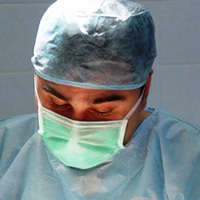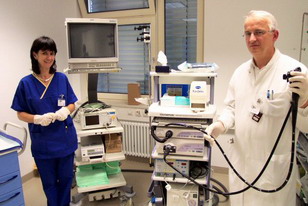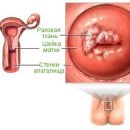So, you have a polyp colon, and doctors insist on removing it. What to choose - Operation or endoscopic polypectomy? You will receive an answer to this question by reading this article.
Content
Operation and endoscopic polypectomy: how it happens
 Operation: Surgeons Through incision in the abdominal wall under anesthesia, you remove the part of the intestines where the polyps were detected. Some surgical operations are made by laparoscopic equipment. This avoids a large cut on the stomach, everything comes down to 3 - 4 small holes through which the laparoscope is inserted. Keeping all the advantages of ordinary surgical intervention, laparoscopy adds one more: the patient stands on his feet literally the next day. But all the negative sides of the operation are preserved.
Operation: Surgeons Through incision in the abdominal wall under anesthesia, you remove the part of the intestines where the polyps were detected. Some surgical operations are made by laparoscopic equipment. This avoids a large cut on the stomach, everything comes down to 3 - 4 small holes through which the laparoscope is inserted. Keeping all the advantages of ordinary surgical intervention, laparoscopy adds one more: the patient stands on his feet literally the next day. But all the negative sides of the operation are preserved.
Endoscopic polypectomy: through a colonoscope, inserted into an anal hole, with the help of a special diathermic loop polyps separated from the intestine and remove. At the same time there is cutting and cavity.
Take a polyp for memory, such as pebbles from the gallbladder, it is impossible. Doctors send it to a morphological study, the results of which determine the further tactics of treatment. If the polyp turned out to be completely benign, the patient is considered cured, but 1 time per year he must undergo a control examination. If the focus of malignancy was in the very polype, but not penetrated into the leg, then endoscopic intervention is enough, although the patient remains under a more thorough observation of the doctor and must undergo a control examination more often than a patient with completely benign polyps, that is, 3-4 times a year. If cancer cells germinate in the depths of the intestine, you have to resort to surgical intervention. But this happens rarely.
Anesthesia is not a joke
Endoscopic polypectomy: Narcosis does not apply. In 99% of cases (exception - patients with a pronounced adhesive process, disorders in the field of anal channel) is done without anesthesia, because in the mucous membrane (the surface layer of the colon) there are no painful receptors and, when removing polyps, the patient does not feel pain - only some discomfort.
Operation: Anastomosis is added to the hazards of surgical intervention, because after removing part of the intestine, its ends are stitched and the so-called intercircuit anastomosis is superimposed, which does not always heal well, and occasionally (2 cases per 1000) requires a re-operation - in the same place, but already For another reason.
The most difficult department for the operation on the colon is a straight intestine: its length is only 17 - 18 cm, but it is very difficult to get to it. And the lower in the rectum (that is, the closer to the anal hole) is a polyp, the more difficult surgical intervention. Earlier, and in some way, unfortunately, and now, if the polyp was at a distance of no more than 7 cm from the anal hole, the direct intestine. It was completely removed and a sigmoid gut was removed on the front abdominal wall. The people are called «walk with tube», and for the patient means receiving disability.
In our institute, technically very complex surgical operations are now developed, which even at a low location of the polyps allow the patient to avoid this fate if endoscopic intervention is impossible.
Polyps are of different values - from 5 mm to 15 cm, therefore the degree of intervention is also distinguished. Do not compare the burn, which remains after removing the polyp on the leg (this is 0.3 mm - a maximum of 1 cm) and the polyp with a base of 15 cm. In the first case, the patient with a couple of days after the endoscopic procedure goes to the liquid table: he can eat only kasya, baby mashed potatoes, drink juices, and after 3 days it goes to an extract and in a week he feels a healthy person in a week. In the second case, bedding and liquid table are prescribed for three days, the patient is prescribed vaseline oil so that the chair does not injure the burn area. It can start working after 2 - 3 weeks.
The risk of infection, which is most often afraid, with endoscopic intervention is excluded. Endoscopes have been processed by special disinfecting solutions for 15 years, which exclude the possibility of infection with hepatitis and HIV infection. Upsed food, «Traveling» In the intestine by burning to the anal hole, also does not represent dangers due to the protective forces of the human body.
A large number of relapses (20-30%) is fraught with wrap, less traumatic type of surgical intervention, when an incision is made on the opposite tumor of the intestine, the tumor is excised, and this section is sewn. Kolotomius avoids the removal of the intestine, but increases the risk of recurrence.
Even after the successful removal of benign neoplasm, no one can give a guarantee that somewhere else in the other place the colon will not grow another polyp. The higher the polyp, the less noticeably for the patient removal of the intestine. But she is heavenly. How many times can you cut off a piece of it?.. And the intervention on the rectum sometimes leads to a violation of its functions, and the greater the new formation, the fact that this is more noticeable: the patient may have frequent urge to empty the intestines, because after removing the rectum there is no body where the calf could accumulate.
Endoscopic polypectomy: recurrences do not occur after the removal of polyps on the legs. The larger the polyp, the greater the probability of recurrence. Even in the case of recurrence, endoscopic intervention can be repeated: the intestine is not cut off, so it does not get shorter.
The former endoscopic polypectomy techniques were to remove the polyp in pieces, because throwing a loop to a large polyp is impossible. Part of the fabric often remained at the base, and this led to a relapse (up to 40% of cases). I had to resort to endoscopic interference again, and so before the victorious.
We have developed an endoscopic electrore method, which allows you to cut off strailes or on a wide base of the polyps together with the mucous membrane, that is, the basis on which the neoplasm has grown. The frequency of relapses immediately decreased to 7%. Repeated endoscopic intervention helps another 90% of patients from this number, but 3% of patients with persistent recurrence still remain. Then it is necessary as long-sized surgery.
Now ultrasonic colonoscopy allows us to initially evaluate the basis of large neoplasms (these are polyps on broad bases or sharpening) and select patients for which endoscopic removal of polyps prospectively. The assessment of the foundation gives confidence that there is no zinc. Endoscopic intervention is inappropriate for patients who have a globalism went deeply mucous membrane.
Take a proctologist if:
- Blood is blood from the anal hole. The lower the polyp is located, the more often it is injured and »Beats alarm» Through bleeding. Let his reason be a banal crack of the rear pass or hemorrhoids, a visit to the doctor will remove all doubts and relocate from anxiety;
- You have a chairs. If you climbed the milk with cucumbers, it's one thing, but when the alternation of diarrhea with constipation becomes the norm, you can not allow you to postpone.
Remember: Polyps do not hurt!
Everyone should know
Biopsy - Fence of fabrics, organs or suspension cells for microscopic research to diagnose or study the dynamics of the pathological process and the effectiveness of treatment.
Defecation - intestinal emptying.
The colonoscope is a flexible apparatus with a length from 1 to 1.7 m, a diameter of 0.8 - 1.5 cm, which is entered through the anal hole and allows you to view the intestines up to the small intestine, reveal the neoplasms, to make a biopsy. In the method of pushing the device, the force is introduced into the colon. The rotation technique allows separate sections of the intestines (sigmoid and cross-rod) literally to strive to the harmonicha for the machine, and the patient does not feel pain at all.
EXTERPIATION - removal of the intestine.









